F
| a transitional device consisting of a gradual change in the intensity of an image or sound, such as from a normally-lit scene to darkness (fade out, fade-to-black) or vice versa, from complete black to full exposure (fade in), or from silence to sound or vice versa; a 'fade in' is often at the beginning of a sequence, and a 'fade out' at the end of a sequence; a cross-fade means fading out from one scene and into another (often with a slight dissolve or interruption). |
 Examples: Face-outs usually occur at the end of a sequence, and fade-ins at the beginning of a sequence Examples: Face-outs usually occur at the end of a sequence, and fade-ins at the beginning of a sequence |
|
| refers to a light-hearted, gleeful, often fast-paced, crudely humorous, contrived and 'over-the-top' comedy that broadly satirizes, pokes fun, exaggerates, or gleefully presents an unlikely or improbable stock situation (e.g., a tale of mistaken identity, cross-dressing, etc.) often characterized by slapstick, pratfalls, and other physical antics; types of farces include screwball comedy, bedroom/sex farce/comedy; contrast to parody and satire. | ||
| refers to a film editing technique of consecutive short, staccato cuts or shots of very brief duration to create an effect | Examples: the famous shower slashing-murder scene in Hitchcock's Psycho (1960) or the kinetic 'Can-Can' dance sequence in Baz Luhrmann's Moulin Rouge! (2001) | |
(or accelerated motion) |
a camera device or effect to compress reality and highlight a scene or cause a dramatic effect, created by filming a scene with the film running at a rate less than the normal 24 frames per second and then projecting it back at standard speed, thereby creating the effect of moving faster than normal; generally used for comic effect; contrast to slow-motion or time-compression. | |
| a term that refers to focusing on and/or highlighting a specific subject or action in a shot | ||
| a "full-length" motion picture, one greater than 60 minutes in length - but usually about 90-120 minutes on one particular topic; also known as a theatrical; contrast to short or short subject. | ||
| a term often used before the 1970s to refer to a 20 to 45 minute film (longer than a short subject but shorter than a feature film), usually a "making of" or "behind the scenes" mini-documentary, or an extended trailer, which was usually displayed by theater owners to "sell" a film for exhibition in their movie house -- nowadays, featurettes are commonly run on premium cable stations, or offered as a 'bonus feature' as part of a DVD's extras; see also "Making of..." | Examples: One of the most notorious featurettes was Alfred Hitchcock's extended trailer for Psycho (1960), in which the director explored the set of the Bates Motel, and coyly described the film's murders | |
| usually a light-hearted, upbeat comedy or romance that ends with an audience-pleasing conclusion; sometimes used derogatively; compare to tearjerker |  Examples: Singin' in the Rain (1952), Rocky (1976), Ferris Bueller's Day Off (1986), Field of Dreams (1989), When Harry Met Sally... (1989), Four Weddings and a Funeral (1994), Amelie (2001) Examples: Singin' in the Rain (1952), Rocky (1976), Ferris Bueller's Day Off (1986), Field of Dreams (1989), When Harry Met Sally... (1989), Four Weddings and a Funeral (1994), Amelie (2001) |
|
| an event at which films can often be premiered, exhibited, awarded, and engaged in distribution deals, such as Cannes, Toronto, Sundance, etc.; also known as fest |  Example: the Cannes Film Festival (France) is the best known of various film festivals, with its Palm D'Or grand award Example: the Cannes Film Festival (France) is the best known of various film festivals, with its Palm D'Or grand award |
|
| a cliched term popularized by pop artist/painter Andy Warhol in the late 60s, who predicted that everyone could be famous for 15 minutes and experience a moment of 'crowning glory'; aka one-hit wonders; due to today's increasing demands for pseudo-celebrities or 'personalities', headline-grabbers, and the widespread dissemination of information by cable TV, talk radio, and the WWW, it may be possible for everyone to 'bask in the limelight' for a fleeting moment (a flash in the pan). |  Examples: Tiny Tim, Dr. Laura, Amy Fisher, Tonya Harding, Kato, Rodney King, Tammy Faye Bakker, Jessica Lynch, Pee Wee Herman, Mr. T., Reality TV show contestants (i.e., Omarosa), Ken Jennings (on Jeopardy), etc. Examples: Tiny Tim, Dr. Laura, Amy Fisher, Tonya Harding, Kato, Rodney King, Tammy Faye Bakker, Jessica Lynch, Pee Wee Herman, Mr. T., Reality TV show contestants (i.e., Omarosa), Ken Jennings (on Jeopardy), etc. |
|
| (1) as a verb, to record a scene or make (or lense) a motion picture; (2) as a noun, refers to a motion picture, or (3) the thin strip of material on the film negative (with a base and light-sensitive coating of emulsion) that is used to create images - through light exposure. |  |
|
| the examination or study of film as an art form | ||
| unwanted film damage that could be a defect or error - dust, hair, specks, emulsion scratches, splices, reel-change marks, a hiss, crackle or pop on the soundtrack, mottling of the image, scratches on the negative being printed positive, etc.; film preservation, restoration, and archival efforts help to keep older, decomposing, and endangered films from deteriorating and acquiring artifacts, through painstaking processes (often digital restoration) |  Example: heavy damage and scratches in a still from Judex (1916), a silent serial in twelve episodes made by French director Louis Feuillade Example: heavy damage and scratches in a still from Judex (1916), a silent serial in twelve episodes made by French director Louis Feuillade |
|
| a short section of film removed from a movie and often exhibited; a part of a film, and sometimes a complete scene or sequence, taken from a film; similar to an excerpt. | ||
| many elements within a film (the use of music, audio, costuming, scripting, camera angles, framing, shot duration, a character's actions, etc.) speak a 'language,' 'grammar,' or code that when used by the filmmaker help the viewer to understand more about the plot and its characters | Examples: silence (long pauses) in dialogue, odd camera angles, gothic clothing, loud or harsh symphonic bursts, dark shadowing, etc. all communicate meaning (the character is evil or villainous, possibly) and are used by the filmmaker to imply a certain meaning for the film viewer. | |
| an early movement in French cinema to film more respectable stage productions | ||
| refers to various technical or logistical aspects which make up, compose, or produce a finished film, including Cinematography (Camera Movement), Sound and Editing, Lighting, Framing, Acting, and the Narrative itself | ||
| refers to the measurement of a width of a film strip (in millimeters) used in a camera; see 35mm, film stock, Cinerama, Cinemascope, etc.; see also digital video |
 Example: from The Maltese Falcon (1941), the most common film gauge - used for most films until 1953, 35mm film with four perforations on each side for each frame, and running at 24 fps; the frame area was 1" wide and 3/4" high, producing an aspect ratio of 1.33:1 (called the Academy ratio) Example: from The Maltese Falcon (1941), the most common film gauge - used for most films until 1953, 35mm film with four perforations on each side for each frame, and running at 24 fps; the frame area was 1" wide and 3/4" high, producing an aspect ratio of 1.33:1 (called the Academy ratio) |
|
| the amount of light-sensitive material in the film's coating or emulsion; results can either be fine-grained (or sharp) - that requires more light for filming, or excessively grainy (or coarse) - best for low-light situations. | ||
| a collective term used to refer to a person(s) who have a significant degree of control over the creation of a film: directors, producers, screenwriters, and editors. | See section of site on "Greatest Directors." | |
| a French phrase literally meaning "black film" that developed in the early 40s; refers to a genre of mostly black/white films that blossomed in the post-war era in American cinema, with bleak subject matter and a somber, downbeat tone; the plot (often a quest), low-key lighting (harsh shadows and chiaroscuro) often in night scenes, camera angles (often canted or high angle shots), the setting (the gloomy underworld of crime and corruption), iconography (guns, urban settings), characters (disillusioned, jaded), and other elements (voice-overs and flashbacks) combined to present a dark atmosphere of pessimism, tension, cynicism, or oppression. Film noirs, often crime films, were usually set in grim and seedy cities, with characters including criminals, anti-heroes, private detectives, and duplicitous femme fatales; see also tech-noir |  Examples: American films of the 1940s and early 1950s, including The Maltese Falcon (1941), Double Indemnity (1944), Sorry, Wrong Number (1948), and Sunset Boulevard (1950). Also present day noirs, such as Body Heat (1981)and The Man Who Wasn't There (2001); Carl Reiner's Dead Men Don't Wear Plaid (1982) was a parody of film noir (and contained excerpted footage from classic film noir films) Examples: American films of the 1940s and early 1950s, including The Maltese Falcon (1941), Double Indemnity (1944), Sorry, Wrong Number (1948), and Sunset Boulevard (1950). Also present day noirs, such as Body Heat (1981)and The Man Who Wasn't There (2001); Carl Reiner's Dead Men Don't Wear Plaid (1982) was a parody of film noir (and contained excerpted footage from classic film noir films) |
|
| a comprehensive (often chronological by year) listing of films featuring the work of an actor/actress, director, or other crew member; may also be a list of films for a specific genre or topic; a filmographer is another term for a film-maker or a person who studies film | See filmographies of many prominent actors and actresses, or director-filmographies. | |
| an evaluative oral or written judgment about the quality of a movie, based upon various assumptions, facts, biases, etc; professional film reviewers are known as critics; a film review usually includes a brief synopsis (avoiding spoilers, usually), a balanced notation of both the film's plusses and minuses, quotable wording, and some judgments; more extensive, in-depth film evaluations are called analytical essays. |
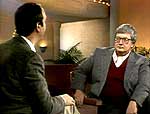 Film critics-reviewers Gene Siskel and Roger Ebert in the mid-80s presenting a critique on their TV show about Blue Velvet (1986) Film critics-reviewers Gene Siskel and Roger Ebert in the mid-80s presenting a critique on their TV show about Blue Velvet (1986) |
|
| refers to film size or gauge (8mm, 16mm, 35mm, 70mm, 105mm, for example), and film speed, among other things; also refers to the raw unused, unexposed film medium where photographic images are stored; various kinds of film stock include tungsten (for use with artificial light, usually indoors) and daylight film stock (for use with natural light, usually outdoors) | ||
| a particular story-telling approach, literally, to have one film within another; in some cases, the characters are aware of the 'film-within-a-film,' and break the fourth wall and enter into or interact with it; aka subset film or picture within a picture |  Examples: the opening of Butch Cassidy and the Sundance Kid (1969) with silent film footage of the historical Butch Cassidy's 'Hole in the Wall' Gang; also found in Buster Keaton's Sherlock, Jr. (1924); the "News on the March" segment in Citizen Kane (1941), Never Give a Sucker an Even Break (1941), The Purple Rose of Cairo (1985), The Player (1992), Last Action Hero (1993), Wes Craven's New Nightmare (1994), and Steven Soderbergh's Full Frontal (2002) Examples: the opening of Butch Cassidy and the Sundance Kid (1969) with silent film footage of the historical Butch Cassidy's 'Hole in the Wall' Gang; also found in Buster Keaton's Sherlock, Jr. (1924); the "News on the March" segment in Citizen Kane (1941), Never Give a Sucker an Even Break (1941), The Purple Rose of Cairo (1985), The Player (1992), Last Action Hero (1993), Wes Craven's New Nightmare (1994), and Steven Soderbergh's Full Frontal (2002) |
|
| glass, plastic, or gelatinous substance placed before or behind a camera lens to change the effect and character of the lighting within the film's frame | ||
| the last edited version of a film as it will be released; see also rough cut | ||
(lens) |
an extreme type of super wide-angle lens with a very short focal point (and nearly infinite depth-of-field), that exaggerates and distorts the linear dimensions of the image, giving it a sense of curvature | 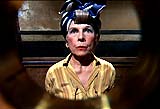 Example: the image of Ruth Gordon (as nosey neighbor Minnie Castevet) in a ludicrously distorted fish-eye view seen through neighbor Rosemary's (Mia Farrow) security door peephole in Rosemary's Baby (1968)); also common in dream sequences Example: the image of Ruth Gordon (as nosey neighbor Minnie Castevet) in a ludicrously distorted fish-eye view seen through neighbor Rosemary's (Mia Farrow) security door peephole in Rosemary's Baby (1968)); also common in dream sequences |
| a film (usually humorous) in which the main character(s) faces 'culture shock' by being placed in unfamiliar or new surroundings or situations | Examples: any version of A Connecticut Yankee in King Arthur's Court, Tarzan's New York Adventure (1942), Trading Places (1983), 'Crocodile' Dundee (1986), Babe: Pig in the City (1998) | |
| a filmic technique that alters the natural order of the narrative; a flashback may often be the entire film; it takes the story order back chronologically in time to a previous or past event, scene, or sequence that took place prior to the present time frame of the film; the flashbacked story that provides background on action and events is often called the backstory; contrast to flash-forward |
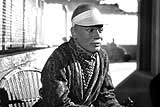 Examples: Citizen Kane (1941) is composed mostly of flashbacks and flash-forwards - i.e., Joseph Cotten in a rest home remembering the past, in a flashback; also many film noirs begin with a flashback, such as Mildred Pierce (1945) and Out of the Past (1947) Examples: Citizen Kane (1941) is composed mostly of flashbacks and flash-forwards - i.e., Joseph Cotten in a rest home remembering the past, in a flashback; also many film noirs begin with a flashback, such as Mildred Pierce (1945) and Out of the Past (1947) |
|
(or flash-ahead) |
simply put, the opposite of flashback; a filmic technique that depicts a scene, event or shot taking place (or imagined) or expected that is projected into a future time beyond the present time of the film, or it can be a flashforward from the past to the present | Example: very common in futuristic science-fiction films (e.g., 2001: A Space Odyssey (1968), or Jacob's Ladder (1990)), or in reflecting a character's hopes/dreams |
(or shot, or cut) |
a quick or brief shot (or image), sometimes as short as a single frame, that is inserted between two other shots that can barely be perceived or is subliminal, for the intention of producing a shock or sudden dramatic effect | Example: in Hitchcock's black and white Spellbound (1945), two frames are hand-tinted red (Hitchcock's first use of color) in a gigantic closeup of a gun that rotates slowly and fires directly at the camera  |
| transitory, impermanent success or recognition; derived from panning for gold experience; see fifteen minutes of fame | ||
| a section of a studio's set, consisting of a constructed wooden frame covered with materials (such as plywood that is treated or covered with fabric, metal, paint, wallpaper, etc.) | ||
| the flickering image in early films gave rise to the generic term flicks when referring to the movies; often used in a condescending way, such as stating that a film is a 'horror flick' or 'chick-flick' | ||
| refers to the unsteady, stroboscopic, fluctuating effect perceived by the viewer, often produced by an improperly-photographed or projected film; similar to the old-time movie effect | ||
| a lamp that provides general diffuse lighting on a studio set | ||
| a film that is a failure at the box-office; also known as floppola, bomb, turkey. See Greatest All-Time Film Flops. | Examples: Heaven's Gate (1980) and Ishtar (1987)are two notorious examples of major flops | |
| refers to the degree of sharpness or distinctness of an image (or an element of an image such as a person, object, etc.); as a verb, it refers to the manipulation or adjustment of the lens to create a sharper image; terms related are deep focus, shallow focus (very common in close-ups), soft focus, and rack focusing |  |
|
| an acting role that is used for personality comparison or contrast, usually with the protagonist or main character, as a means to show and highlight a character trait | ||
| in the post-production and editing stage of a film's production, the foley artist (named after pioneer Jack Foley) creates or adds incidental sound effects/noises (e.g., footsteps, gunshots, kisses, fight-sounds, punches, storm noises, slamming doors, explosions, etc.) that are synchronized to the film as it is projected in order to match its visual component, often with props that mimic the action | ||
(or following shot) |
a shot with framing that shifts to follow and keep a moving figure or subject onscreen; also known as a type of tracking shot | |
|
refers to a cinematic work that comes after, regardless of whether it is a sequel or a prequel; contrast to a prequel, serial, series, sequel, spin-off or redo, reimagining or remake |
Examples: Star Wars: Episode 1 - The Phantom Menace (1999) was a follow-up to the sequel, Star Wars: Episode 6 - Return of the Jedi (1983), as was Toy Story 2 (1999) to Toy Story (1995) | |
| any length, portion or sequence of film (either shot or to be shot) measured in feet; also refers to a particular sequence of events depicted in a motion picture | ||
(abbreviated as f.g.) |
objects or action closest to the camera; contrast to background (abbreviated as b.g.) |  Example: From Here to Eternity (1953), with Montgomery Clift in the foreground and Burt Lancaster in the background Example: From Here to Eternity (1953), with Montgomery Clift in the foreground and Burt Lancaster in the background |
| a feature-length motion picture produced outside the US with a predominantly non-English dialogue track | 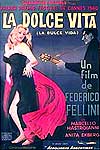 Example: La Dolce Vita (1960) - an Italian film Example: La Dolce Vita (1960) - an Italian film |
|
| to supply hints (in the form of symbols, images, motifs, repetition, dialogue or mood) within a film about the outcome of the plot, or about an upcoming action that will take place, in order to prepare the viewer for later events, revelations, or plot developments; also, ominous music often foreshadows danger or builds suspense | Example: the possibility of danger/murder, signaled and foreshadowed by the playing of ominous music, in Halloween (1978); or the death of Lester Burnham (Kevin Spacey) was foreshadowed in his opening voice-over monologue in American Beauty (1999) | |
| a phrase often used in special trade advertisements (in publications such as Variety) that are paid for by studios to promote "Oscar-worthy" films (and their actors) and create Oscar buzz for Academy Award nominations, especially for borderline films and/or lesser known indie efforts and lesser-known performers that would probably be overlooked without the additional publicity, aka FYC | 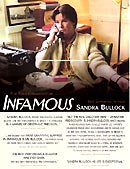 Example: A typical "For Your Consideration" ad by Warner Bros. touted Sandra Bullock's Best Supporting Actress-worthy performance in Infamous (2006) Example: A typical "For Your Consideration" ad by Warner Bros. touted Sandra Bullock's Best Supporting Actress-worthy performance in Infamous (2006) |
|
| the size or aspect ratio of a film frame | ||
| refers to the imaginary, illusory invisible plane through which the film viewer or audience is thought to look through toward the action; the fourth wall that separates the audience from the characters is 'broken through' when the barrier between the fictional world of the film's story and the "real world" of the audience is shattered - when an actor speaks directly to the viewers by making an aside | Examples: the conclusion of The Great Train Robbery (1903) when the gunman fires directly at the audience, Woody Allen's asides in Annie Hall (1977), the end of GoodFellas (1990), and all throughout Ferris Bueller's Day Off (1986) | |
| refers to a single image, the smallest compositional unit of a film's structure, captured by the camera on a strip of motion picture film - similar to an individual slide in still photography; a series of frames juxtaposed and shown in rapid succession make up a motion (or moving) picture; also refers to the rectangular area within which the film image is composed by the film-maker - in other words, a frame is what we see (within the screen); see fpsand framing below. |
|
|
frame rate |
refers to the rate at which film stock passes in front of the camera's aperture while filming; present-day films are usually run through a camera or projector at a frame rate (running speed or camera speed) of 24 fps (frames per second); older films, made at 18 fps, appear jerky and sped-up when played back at 24 fps - this technique is referred to as undercranking; overcranking refers to changing the frame rate (i.e., shooting at 48 or 96 fps), thereby producing slow-motion action when viewed at 24 fps. | Examples: Action films often film explosions with overcranking, so that the action is prolonged; also, the William Tell Overture sequence in A Clockwork Orange (1971) is an example of undercranking |
(or framed shot) |
refers to the way a shot is composed, and the manner in which subjects and objects are surrounded ('framed') by the boundaries or perimeter of the film image, or by the use of a rectangle or enclosing shape (such as a shadow, mirror, door or hallway) within the film image; also, camera angles such as low-angle and high-angle shots contribute to the framing; reframing refers to short panning or tilting movements of the camera to adjust to the character's movements and keep them onscreen, centered, and in the frame. | Example: in The Godfather: Part II (1974), the sequence of young Don Vito Corleone scampering over rooftops following Fanucci |
(or freeze-frame) |
an optical printing effect in which a single frame image is identically repeated, reprinted or replicated over several frames; when projected, a freeze frame gives the illusion of a still photograph in which the action has ceased; often used at the end of a film to indicate death or ambiguity, and to provide an iconic lasting image |  Example: in the opening of All About Eve (1950) - the freeze frame on the character of Eve (Anne Baxter) as she reached for the Sarah Siddons Award as Best Actress; also the final freeze-frame image of Butch Cassidy and the Sundance Kid (1969) (pictured) as they were gunned down, Example: in the opening of All About Eve (1950) - the freeze frame on the character of Eve (Anne Baxter) as she reached for the Sarah Siddons Award as Best Actress; also the final freeze-frame image of Butch Cassidy and the Sundance Kid (1969) (pictured) as they were gunned down,  the ending of Gallipoli (1981) (pictured also), the ending of The 400 Blows (1959, Fr.), a stopped frame toward the beginning of It's a Wonderful Life (1946), and the conclusion of the remake Breathless (1983); the first or earliest use of the "freeze-frame" was in Alfred Hitchcock's British comedy Champagne (1928, UK) the ending of Gallipoli (1981) (pictured also), the ending of The 400 Blows (1959, Fr.), a stopped frame toward the beginning of It's a Wonderful Life (1946), and the conclusion of the remake Breathless (1983); the first or earliest use of the "freeze-frame" was in Alfred Hitchcock's British comedy Champagne (1928, UK) |
| a film process developed in the 1950s in which actors and foreground objects were filmed in front of a projection screen, with a previously-filmed background projected onto it |  Example: the Dawn of Man sequence in 2001: A Space Odyssey (1968) Example: the Dawn of Man sequence in 2001: A Space Odyssey (1968) |
|
| the scale measurement of the size of the opening of the iris (the opening that lets light in) on a lens; common f-stops are 1.4, 2, 2.8, 4, 5.6, 8, 11, 16, and 22; the smaller the number, the larger the opening, and the more light that is allowed | ||
| abbreviation for special (or visual) effects | ||
| abbreviation for 'For Your Consideration' (see above) | ||
źródło:www.filmsite.org
 Examples:
Examples: 